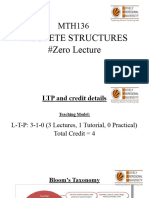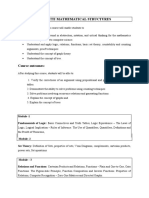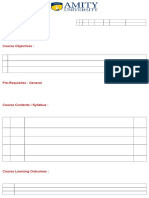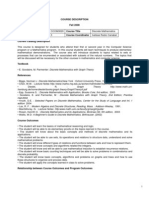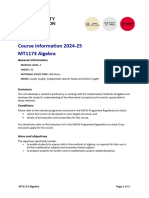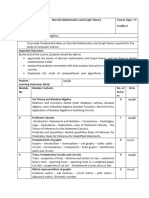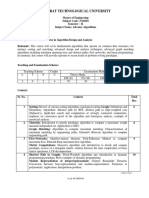0 ratings0% found this document useful (0 votes)
66 viewsCS203 PDF
CS203 PDF
Uploaded by
SRINIVASA RAOCS203 Discrete Structures is a 3 credit core course for second year B. Tech. Computer Science students. The course introduces discrete mathematical concepts like logic, proofs, sets, counting, probability, graphs, trees, and Boolean algebra. It aims to teach logical and mathematical thinking. Students are evaluated through a final exam, two quizzes, surprise quizzes, and assignments. Topic areas include logic and proofs, sets and functions, counting and probability, relations, graphs, trees, and Boolean algebra modeling computation. Recommended textbooks include Discrete Mathematics and its Applications by Rosen and Elements of Discrete Mathematics by Liu and Mohapatra.
Copyright:
© All Rights Reserved
Available Formats
Download as PDF, TXT or read online from Scribd
CS203 PDF
CS203 PDF
Uploaded by
SRINIVASA RAO0 ratings0% found this document useful (0 votes)
66 views1 pageCS203 Discrete Structures is a 3 credit core course for second year B. Tech. Computer Science students. The course introduces discrete mathematical concepts like logic, proofs, sets, counting, probability, graphs, trees, and Boolean algebra. It aims to teach logical and mathematical thinking. Students are evaluated through a final exam, two quizzes, surprise quizzes, and assignments. Topic areas include logic and proofs, sets and functions, counting and probability, relations, graphs, trees, and Boolean algebra modeling computation. Recommended textbooks include Discrete Mathematics and its Applications by Rosen and Elements of Discrete Mathematics by Liu and Mohapatra.
Original Title
CS203.pdf
Copyright
© © All Rights Reserved
Available Formats
PDF, TXT or read online from Scribd
Share this document
Did you find this document useful?
Is this content inappropriate?
CS203 Discrete Structures is a 3 credit core course for second year B. Tech. Computer Science students. The course introduces discrete mathematical concepts like logic, proofs, sets, counting, probability, graphs, trees, and Boolean algebra. It aims to teach logical and mathematical thinking. Students are evaluated through a final exam, two quizzes, surprise quizzes, and assignments. Topic areas include logic and proofs, sets and functions, counting and probability, relations, graphs, trees, and Boolean algebra modeling computation. Recommended textbooks include Discrete Mathematics and its Applications by Rosen and Elements of Discrete Mathematics by Liu and Mohapatra.
Copyright:
© All Rights Reserved
Available Formats
Download as PDF, TXT or read online from Scribd
Download as pdf or txt
0 ratings0% found this document useful (0 votes)
66 views1 pageCS203 PDF
CS203 PDF
Uploaded by
SRINIVASA RAOCS203 Discrete Structures is a 3 credit core course for second year B. Tech. Computer Science students. The course introduces discrete mathematical concepts like logic, proofs, sets, counting, probability, graphs, trees, and Boolean algebra. It aims to teach logical and mathematical thinking. Students are evaluated through a final exam, two quizzes, surprise quizzes, and assignments. Topic areas include logic and proofs, sets and functions, counting and probability, relations, graphs, trees, and Boolean algebra modeling computation. Recommended textbooks include Discrete Mathematics and its Applications by Rosen and Elements of Discrete Mathematics by Liu and Mohapatra.
Copyright:
© All Rights Reserved
Available Formats
Download as PDF, TXT or read online from Scribd
Download as pdf or txt
You are on page 1of 1
CS203 Discrete Structures
Credits: 3-0-0-3 Approval: Approved in 3rd Senate
Students intended for: 2ndyear B. Tech. CSE
Elective or Core: Core
Prerequisite: Consent of the faculty member Semester: Odd or Even
Course objective:
According to Wikipedia article on this topic, “discrete structure is the study of mathematical
structures that are fundamentally discrete rather than continuous.”The objective of this course is to
teach students how to think logically and mathematically. The course stresses on mathematical
reasoning and describes different ways in which mathematical problems could be solved. There are
four thematic areas covered in this course: mathematical reasoning, combinatorial analysis, discrete
structures, and mathematical modeling. Topics in this course include logic, proofs, set theory,
counting, probability theory (the discrete part of the subject), graph theory, trees, Boolean algebra,
and modeling computation. This course serves as an introductory course in discrete mathematics for
second year B. Tech. Computer Engineering students.
Evaluation:
Final exam
Quiz 1
Quiz 2
Surprise Quizzes
Assignments
Course content:
• Logics and Proofs: Propositional Logic, Applications of Propositional Logic, Propositional
Equivalences, Predicates and Quantifiers, Nested Quantifiers, Rules of Inference, Introduction
to Proofs, Proof Methods and Strategies.
• Sets, Functions, Sequences, Sum, and Matrices: Sets, Set operators, Functions, Sequences and
Summations, Cardinality of Sets, Matrices
• Counting and Discrete Probability: Basics of Counting, Pigeonhole Principle, Permutations and
Combinations, Introduction to Discrete Probability, Probability Theory, Bayes’ Theorem,
Expected Value and Variance
• Relations: Relations and Their Properties, n-ary Relations and Their Applications, Representing
Relations, Closures of Relations, Equivalence Relations, Partial Orderings
• Graphs: Graphs and Graph Models, Representing Graphs and Graph Isomorphism,
Connectivity, Euler and Hamilton Paths, Shortest-Path Problems, Planar Graphs, Graph
Coloring
• Trees: Introduction to Trees, Application of Trees, Tree Traversal, Spanning Trees, Minimum
Spanning Trees
• Boolean Algebra and Modeling Computation: Boolean Algebra, Representing Boolean
Functions, Logic Gates, Minimization of Circuits, Language and Grammars, Finite-State
Machines, Language Recognition, Turing Machines
Readings (including but not restricted to the following):
Kenneth Rosen [KR]. Discrete mathematics and its applications (6th edition).2006. McGraw-Hill
Science/Engineering/Math.
Reference Books:
C. Liu, D. Mohapatra[CM]. Elements of Discrete Mathematics. 2008. Tata McGraw-Hill.
T.Koshy [TK].Discrete mathematics with applications.2003. Academic Press.
J. Hein [JH]. Discrete structures, logic and computability.2009. Jones & Bartlett Publishers.
You might also like
- Scaler Academy Entrance Quiz - Vishnu VardhanDocument8 pagesScaler Academy Entrance Quiz - Vishnu VardhanBramarish Kadakuntla100% (1)
- DM 1Document5 pagesDM 1basualok@rediffmail.comNo ratings yet
- Discrete Mathematics BSIT 2ndDocument1 pageDiscrete Mathematics BSIT 2ndasadarham923No ratings yet
- CE303 Mathematical Foundation of Computer Science (3 1 0 4)Document2 pagesCE303 Mathematical Foundation of Computer Science (3 1 0 4)Tamal ChakrabortyNo ratings yet
- Zero Lecture MTH401.Pptx FinalDocument33 pagesZero Lecture MTH401.Pptx Finalfakedark9182No ratings yet
- Updated Zero Lecture MTH136Document26 pagesUpdated Zero Lecture MTH136hauwauibrahimmagaji532No ratings yet
- Discrete Mathematical StructuresDocument2 pagesDiscrete Mathematical Structuresmundando networksNo ratings yet
- CourseCurriculum (7)Document2 pagesCourseCurriculum (7)Lucky GuptaNo ratings yet
- 4th Semester SyllabusDocument10 pages4th Semester SyllabusKrishu AgrawalNo ratings yet
- Discrete Mathematical Structures: Course Objectives: This Course Will Enable Students ToDocument2 pagesDiscrete Mathematical Structures: Course Objectives: This Course Will Enable Students ToRakshith RakshuNo ratings yet
- Course Outline 2Document4 pagesCourse Outline 2dlpkrshnaNo ratings yet
- Mathematics Analysis and Approaches and Applications and InterpretationsDocument6 pagesMathematics Analysis and Approaches and Applications and InterpretationsTakura DeraNo ratings yet
- Zero Lecture MTH401 2Document27 pagesZero Lecture MTH401 2Joy BoyNo ratings yet
- Course Syllabus - CCOM3020Document3 pagesCourse Syllabus - CCOM3020OEAENo ratings yet
- UT Dallas Syllabus For Math4301.001.11f Taught by Wieslaw Krawcewicz (wzk091000)Document7 pagesUT Dallas Syllabus For Math4301.001.11f Taught by Wieslaw Krawcewicz (wzk091000)UT Dallas Provost's Technology GroupNo ratings yet
- Indian Institue of Technology 1Document67 pagesIndian Institue of Technology 1venkatasaivishwesvarNo ratings yet
- Discrete MathematicsDocument3 pagesDiscrete Mathematicspatelgattu123No ratings yet
- MT3170 Discrete Mathematics and AlgebraDocument2 pagesMT3170 Discrete Mathematics and Algebramrudder1999No ratings yet
- DMS Lecture 1Document18 pagesDMS Lecture 1Imtiaz HusainNo ratings yet
- Discrete MathematicsDocument2 pagesDiscrete MathematicsMubasheerNo ratings yet
- MTH401 #Zero Lecture: Discrete MathematicsDocument26 pagesMTH401 #Zero Lecture: Discrete MathematicsChanchal AlamNo ratings yet
- Zero Lecture MTH401Document25 pagesZero Lecture MTH401Shaik Abdul SalamNo ratings yet
- MTH401 #Zero Lecture: Discrete MathematicsDocument25 pagesMTH401 #Zero Lecture: Discrete MathematicsPubg CloudNo ratings yet
- DM Syllabus and Book List1Document2 pagesDM Syllabus and Book List1Parnika VisputeNo ratings yet
- 03. Discrete MathematicsDocument3 pages03. Discrete Mathematicsnidhi asthanaNo ratings yet
- Pure Mathematics AM 27: SyllabusDocument15 pagesPure Mathematics AM 27: SyllabusAshley MorganNo ratings yet
- SEHH2241 - Discrete StructureDocument3 pagesSEHH2241 - Discrete StructureGlory of Billy's Empire Jorton KnightNo ratings yet
- B-Tech-CSE-Scheme-Syl-CP-s3-s4-draft (1) .PDF (PDFDrive)Document31 pagesB-Tech-CSE-Scheme-Syl-CP-s3-s4-draft (1) .PDF (PDFDrive)anahh ramakNo ratings yet
- CC302B N Discrete MathematicsDocument3 pagesCC302B N Discrete Mathematics21BECE3O151 DEV OZA N.No ratings yet
- Instructor ED NEIL O. MARATAS, Instructor, Math & StatisticsDocument4 pagesInstructor ED NEIL O. MARATAS, Instructor, Math & Statisticsedniel maratasNo ratings yet
- MT1173 AlgebraDocument3 pagesMT1173 AlgebraShirazNo ratings yet
- Discrete Math CoursesDocument8 pagesDiscrete Math Coursesbmenot2No ratings yet
- IB SL AA SyllabusDocument83 pagesIB SL AA SyllabusTariq MahmoodNo ratings yet
- MTH103-course OutlineDocument1 pageMTH103-course Outlinehussainmurtazar644No ratings yet
- AA Syllabus Outline 2019Document87 pagesAA Syllabus Outline 2019derrickzptofficialNo ratings yet
- 1728544664ge 167Document1 page1728544664ge 167786harisafzal786No ratings yet
- JRF CS Syllabus 2024Document4 pagesJRF CS Syllabus 2024shafqatsimailNo ratings yet
- Discrete Structue BD SBDocument3 pagesDiscrete Structue BD SBHuzaifa TyrantNo ratings yet
- Mathematical Foundation For AIDocument3 pagesMathematical Foundation For AIABHIJEET KUMARNo ratings yet
- Discrete Course OutlineDocument2 pagesDiscrete Course Outlinebeshahashenafe20No ratings yet
- Mat2002 Discrete-Mathematics-And-Graph-Theory LT 1.0 1 Mat2002Document2 pagesMat2002 Discrete-Mathematics-And-Graph-Theory LT 1.0 1 Mat2002aaryaveeryadav2005No ratings yet
- Sem1 Course Detail CompiledDocument12 pagesSem1 Course Detail CompiledchyonNo ratings yet
- JHE114Document2 pagesJHE114paulyeboah168No ratings yet
- Mathematics AA HL SyllabusDocument58 pagesMathematics AA HL SyllabusGraciela AudreyNo ratings yet
- Linear AlgebraDocument3 pagesLinear AlgebraMuhammad SaimNo ratings yet
- JEE Main Maths Syllabus 2024 - Download Latest Syllabus PDFDocument3 pagesJEE Main Maths Syllabus 2024 - Download Latest Syllabus PDFharsh.mahori09No ratings yet
- Math 110 SyllabusDocument3 pagesMath 110 SyllabusslapusillydawgNo ratings yet
- Calculus and Analytic GeometryDocument1 pageCalculus and Analytic Geometryemangraphix.e0% (1)
- CourseOutline - Discrete Structures Fall 2022Document4 pagesCourseOutline - Discrete Structures Fall 2022roseNo ratings yet
- Syllabus OutlineDocument88 pagesSyllabus OutlineKazi Ayman RAHMANNo ratings yet
- 3 Sem DMS SyllabusDocument2 pages3 Sem DMS SyllabusSanthosh Y MNo ratings yet
- MAT2040 (Update)Document6 pagesMAT2040 (Update)kristy yangNo ratings yet
- Maths MethodsDocument6 pagesMaths MethodssmaliraissianNo ratings yet
- National University: Syllabus Department of MathematicsDocument9 pagesNational University: Syllabus Department of Mathematicsbdripon100% (1)
- Discrete Mathematics For Computer ScienceDocument2 pagesDiscrete Mathematics For Computer ScienceRatish Kakkad40% (5)
- ORIENTATION of Each Module in DetailDocument19 pagesORIENTATION of Each Module in DetailSanthosh Y MNo ratings yet
- MATH251Document3 pagesMATH251laibaakbar015No ratings yet
- GRE Maths Syllabus (Quantitative Reasoning) : ArithmeticDocument4 pagesGRE Maths Syllabus (Quantitative Reasoning) : ArithmeticAhmed Magdy El-SayedNo ratings yet
- Syllabus PGTsDocument54 pagesSyllabus PGTspriyambada biswalNo ratings yet
- Notification No.233 of 2024Document12 pagesNotification No.233 of 2024SRINIVASA RAONo ratings yet
- DR AyushDocument13 pagesDR AyushSRINIVASA RAONo ratings yet
- Elephant Foot Yam: A Commercial Crop For Orissa: M. Nedunchezhiyan Abhinav Saurabh & Nirakar RanasinghDocument2 pagesElephant Foot Yam: A Commercial Crop For Orissa: M. Nedunchezhiyan Abhinav Saurabh & Nirakar RanasinghSRINIVASA RAONo ratings yet
- The Parrot Who Wouldn'T Talk: NotesDocument26 pagesThe Parrot Who Wouldn'T Talk: NotesSRINIVASA RAONo ratings yet
- Ec 2003Document37 pagesEc 2003SRINIVASA RAONo ratings yet
- CSL105: Discrete Mathematical Structures: Ragesh Jaiswal, CSE, IIT DelhiDocument28 pagesCSL105: Discrete Mathematical Structures: Ragesh Jaiswal, CSE, IIT DelhiSRINIVASA RAONo ratings yet
- Lec. 4: Parallel ComputationDocument4 pagesLec. 4: Parallel ComputationSRINIVASA RAONo ratings yet
- Curriculumn & Syllabus B.tech. (ECE) 16 17Document46 pagesCurriculumn & Syllabus B.tech. (ECE) 16 17SRINIVASA RAONo ratings yet
- Generic ProgrammingDocument15 pagesGeneric ProgrammingSTUTI DikshitNo ratings yet
- Week 5Document44 pagesWeek 5SandhyaNo ratings yet
- PREDICATIVISMDocument2 pagesPREDICATIVISMJoycelyn BangalanNo ratings yet
- DR Benson PDFDocument40 pagesDR Benson PDFNwachinaere NnamdiNo ratings yet
- Econometrics Lecture 01Document36 pagesEconometrics Lecture 01Nayab MirzaNo ratings yet
- Numerical Mathematics With MATLABDocument66 pagesNumerical Mathematics With MATLABReza Abazari87% (15)
- Lesson 2 - CONTINUITY OF A FUNCTIONDocument17 pagesLesson 2 - CONTINUITY OF A FUNCTIONNeo GarceraNo ratings yet
- Mmw-Operations On SetsDocument25 pagesMmw-Operations On SetsCherrylane EdicaNo ratings yet
- Logical Operators - SQL (Samples)Document9 pagesLogical Operators - SQL (Samples)gamersop867No ratings yet
- Regression in Modal LogicDocument21 pagesRegression in Modal LogicIvan José Varzinczak100% (1)
- Lecture Notes On Discrete Mathematics: Eusebius DoedelDocument357 pagesLecture Notes On Discrete Mathematics: Eusebius DoedelKushal GuptaNo ratings yet
- BCA 1yr 2022 24 Discrete MathematicsDocument35 pagesBCA 1yr 2022 24 Discrete Mathematicsziyad aslanbeyNo ratings yet
- Advance Algorithms PDFDocument2 pagesAdvance Algorithms PDFEr Umesh Thoriya0% (1)
- Mit18 100af20 hw1Document2 pagesMit18 100af20 hw1Chandan kumar MohantaNo ratings yet
- SMT1304Document52 pagesSMT1304Purahar sathyaNo ratings yet
- Heuristic Algorithm LectureDocument13 pagesHeuristic Algorithm LectureAwais AliNo ratings yet
- Function - PlacematsDocument4 pagesFunction - PlacematsRomadel PeraltaNo ratings yet
- Elementary Mathematics IDocument67 pagesElementary Mathematics ISolomon BinutuNo ratings yet
- EECS 203: Discrete Mathematics Fall 2019 Natural Deduction Practice ProblemsDocument7 pagesEECS 203: Discrete Mathematics Fall 2019 Natural Deduction Practice ProblemssamNo ratings yet
- PCM SymbolsDocument53 pagesPCM SymbolsSacheen DusaneNo ratings yet
- Dynkin Pi Lambda Nov16Document2 pagesDynkin Pi Lambda Nov16Raphaël FromEverNo ratings yet
- NM TotalDocument163 pagesNM TotalPrashant PrasarNo ratings yet
- Lec 03 TPLDocument28 pagesLec 03 TPLLilian VossNo ratings yet
- MATH 4 The Conditional and The Biconditional HandoutDocument3 pagesMATH 4 The Conditional and The Biconditional Handoutcharlesbenedictgo7No ratings yet
- Chapter 3 Gate Level MinimizationDocument92 pagesChapter 3 Gate Level MinimizationIbrahim IbrahimNo ratings yet
- Functional Equations BookDocument10 pagesFunctional Equations BookMark ZuNo ratings yet
- 47th problem of euclid ringDocument1 page47th problem of euclid ringetochoa22No ratings yet
- Artificial Intelligence A Modern Approach 3rd Edition Chapter 10Document35 pagesArtificial Intelligence A Modern Approach 3rd Edition Chapter 10scyarunya pidikitiNo ratings yet
- Coding PatternsDocument26 pagesCoding Patternshardik Patel100% (1)






